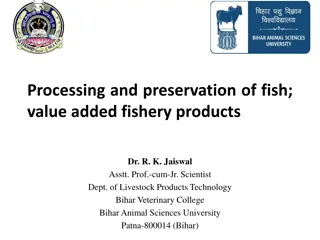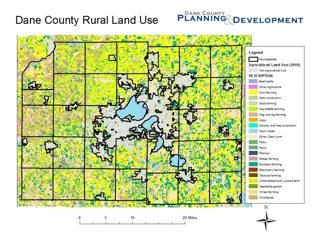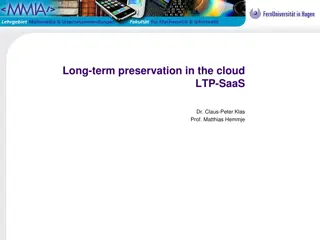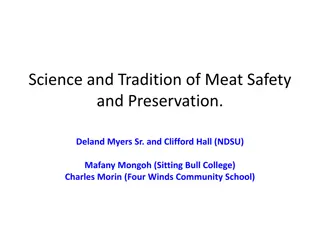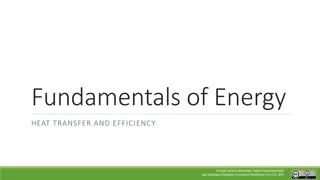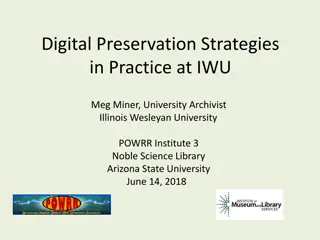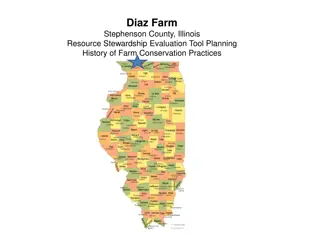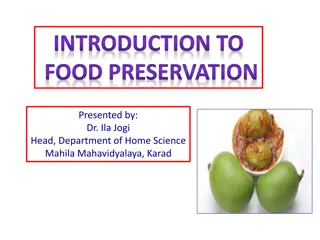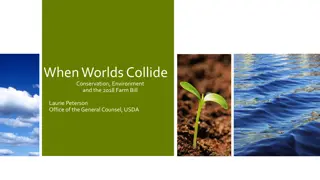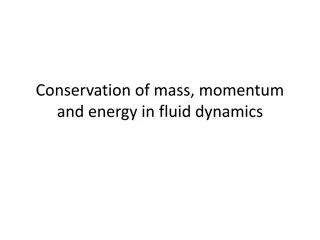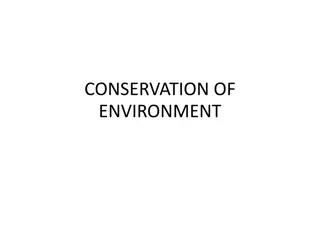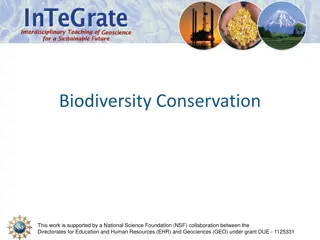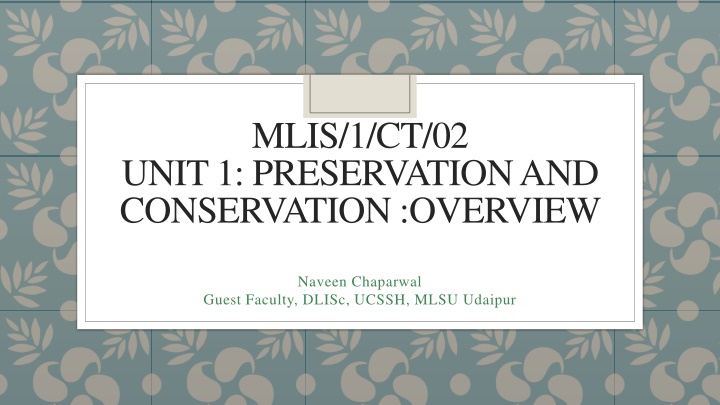
Preservation and Conservation: Overview
In common parlance, Preservation and Conservation are often used interchangeably to mean the process of keeping an object safe from harm or loss, damage, destruction, or decay. Learn about the concepts, definitions, and historical development of preservation and conservation, and understand the need and purpose behind these practices in preserving valuable information sources such as books, journals, and newspapers for future generations.
Download Presentation

Please find below an Image/Link to download the presentation.
The content on the website is provided AS IS for your information and personal use only. It may not be sold, licensed, or shared on other websites without obtaining consent from the author. If you encounter any issues during the download, it is possible that the publisher has removed the file from their server.
You are allowed to download the files provided on this website for personal or commercial use, subject to the condition that they are used lawfully. All files are the property of their respective owners.
The content on the website is provided AS IS for your information and personal use only. It may not be sold, licensed, or shared on other websites without obtaining consent from the author.
E N D
Presentation Transcript
MLIS/1/CT/02 UNIT 1: PRESERVATION AND CONSERVATION :OVERVIEW Naveen Chaparwal Guest Faculty, DLISc, UCSSH, MLSU Udaipur
CONCEPT OF PRESERVATION AND CONSERVATION Meaning of the Terms In common parlance, the words Preservation and Conservation are often used interchangeably to mean: the process of keeping an object safe from harm or loss, damage, destruction or decay, and maintaining it in a reasonably sound condition for present and future use. But strictly speaking, these two words have different, though interrelated and overlapping connotations. Conservation has three aspects: 1) Examination : To determine the nature/properties of materials and causes of deterioration and alteration. 2) Preservation : Adoption of appropriate prophylactic and prospective measures to maintain the specimen in as good a condition as possible, and to prolong its life to whatever extent possible. 3) Restoration : Appropriate remedial treatment of an already affected specimen. Thus, Conservation is an activity of which Preservation is one aspect. In common practice Preservation deals with the maintenance aspect and Conservation with the remedial treatment and restoration of the already damaged specimen.
Definition:- The Library houses the document by conservation the long-term preservation of the items while still allowing the end use to access the material easily, But all library collections experience damage from use and decay from aging. So there is a need of preservation and conservation of library materials. Preservation is a term used for maintaining the integrity of documents deals with- Maintenance of resource To prevent library material from decaying or spoiling To keep in perfect or unaltered condition; maintain unchanged Conservation includes the specific policies and practices involved in- Treatment of the physical items to extend their life To repair Preservation and restoration from loss, damage or neglect
Historical Development From ancient times, man has been collecting information sources. Preservation of knowledge and literature has been done by adopting various techniques and methods. New generation gets to know about the lifestyle, achievements of the older generation on the basis of preservation. The literature written by archaeologists on inscription, stones, sand, paper, leaves and barks of trees is available today also. This is the main source of history. It these were not preserved, we would knowledge. Thus, it can be understood that the tendency in human being to preserve knowledge is from ancient times. behavior, and not have attained
Preservation and Conservation Need and Purpose Compendium of information: Books, journals newspaper are the sources of information. They reflect social, economic, political and cultural life. They also depict the latest trend on all subjects or topic and, as such, they are a valuable asset of our society. Raw Materials of History: The old reading material constitutes the raw materials of our history and provides background information about and event in history. Wide Range of Users: Everyone from a child to an old man, from layman to researchers, turns to information even after hundred years of the publication of the material Future and Heavy Use: Hard copies of the old as well as new materials are prone to decay. So, to provide continuous and wider access to the collection preservation is a must.
GENERAL APPROACH TO PRESERVATION When we talk of the preservation of a document in a library, be it a manuscript or a printed book, or in the form of a non-book item, we look at the three components which constitute it: i) The artefact (the physical entity) ii) The image (the impression on the artefact) iii) The information (the thought content) Preservation of the Artefact and Image For the sake of convenience in this discussion let us use the generic term book to include other reading materials also. A book is almost unusable if its pages are brittle and the brittle pages crack and crumble when turned, or its pages stick to each other and cannot be turned. It is also difficult to use if its binding is in a delicate, fragile state, incapable of holding the pages together. There are the cases where the artefact is in an unhealthy state. Similarly, a book may be tained, and not clearly legible. If the photographs and illustrations are blurred, discoloured or stained, their usefulness is greatly diminished, and in extreme cases these become almost useless. Scratches on films and vinyl recordings reduce their usefulness to a great extent. All these cases are the ones where the image is in a poor state. Deterioration of the artefact and the image is caused by the interplay of three basic factors: i) The inherent characteristics of the materials of which the artefact is composed; ii) The storage condition of the artefact, and iii) The type, intensity and amount of handling of the artefact by the clientele, and the Library staff.
Inherent Characteristics of the Library Materials a) Palm-leaf and Birch-bark Manuscripts Birch tree is of Himalayan Origin. Birch-bark sheets usually consist of a number of layers, collected from the inner side of the bark. These are thin and delicate sheets, containing some natural preservative chemicals (salt of salicylic acid), which are insect-repellent until this natural preservative dries up. Palm-leaf, on the other hand, is of two varieties: tala (Palmyra) and Sritala (talipot). Leaves of tala are thick and coarse and are difficult to handle. These do not absorb ink, and, as such, characters have to be inscribed on them with a stylus on the surface and the grooves filled with ink. The leaves of sritala, on the other hand, are thin, flexible and can be handled or written on like paper. Birch-bark and palm-leaf are natural organic materials. These possess inherent strength to withstand normal environmental effects for many years, even many centuries, if stored properly. But a normal and congenial environmental condition is difficult to maintain for these materials. Over a long period of time, the layers of birch-bark tend to separate and the edges of birch-bark and palm-leaf show a tendency of curling up, if exposed to prolonged dryness. Prolonged dampness also causes their gradual deterioration. The hand-written texts on palm-leaf and birch-bark generally used black carbon ink or pigment, which have the quality of retaining legibility for centuries, if kept away from acidic contaminations.
EVOLUTION OF WRITING MATERIALS The history of writing and the history of human civilization are inseparable entities. Writing, and for that matter printing, notwithstanding our modem technologies, is still by far the most potent and effective tool used in communication, and communication is the foundation of all human progress. Stone and Metal Writings on stone are the oldest examples of writing which have survived the vagaries of nature through centuries. Other more fragile materials, which might have been used for writing at various times, being destructible, have not survived, and our knowledge about them is mainly through literary references, and is not always quite conclusive. Writing on stone had to be done painstakingly with the help of chisels or some sharp tools. Once written, the message acquired a very long life. Inscriptions on stone slabs, on the sides ofrocky mountains or on stone pillars, still exit in many parts of the world. The Rosetta Stone of Egypt which is more than 5000 years old, is one such typical and valuable example. Use of metal plates for writing purposes appears to have been introduced at a later date, but that too, quite early in history. Inscriptions on stone mostly bear texts of special value, royal annals, religious codes of conduct and some such things, and the metal plates were generally used as documents of a more mundane nature like land grants, legal codes, interstate agreements and the like. These are available in a large number in, various museums of the World. But the fact remains that neither stone slabs, nor metal plates could ever achieve the status of books for disseminating knowledge and information, as books do. Clay Tablets Something which is akin to the present day book was created by our ancestors the Sumerians, the Babylonians, the Assyrians and the Hittites. They used tablets made of water cleaned clay. While the clay was still soft, the writer used to inscribe writing on it with the help of a stylus. After the writing was done, the clay tablet was either dried in the sun or for better, durability, burnt in kilns. The tablets, which looked like bricks, were of different shapes and dimensions about five inches long. These burnt tablets were quite hard and almost indestructible.
Papyrus If the clay-tablet was to some extent, akin to our modern book, the papyrus roll, is more nearly its direct ancestor. The Papyrus roll is of equal antiquity as clay tablet. About the time the Babylonians were producing clay-tablets with cuneiform writing, the Egyptians learned to make beautiful writing material from papyrus plant. Papyrus, from which our paper derived its name, is a reed-like plant (Fig. 2). In ancient Egypt it grew abundantly in the shallows of the Nile delta. The stem of the plant is 3 feet to 10 feet in length, triangular and tapering in form. The Egyptians used the stem of the plant for various purposes, such as, basket-making, weaving mats and sails of boats etc. But the most significant use for which papyrus has found its enviable place in history was its use as a writing material. Because of its various uses the growing of the plant was not entirely left to nature. The Egyptians in fact cultivated it in a big way to meet the growing demand for it, specially as writing material. Animal Skin Skin of certain animals has been used as writing material centuries ago. The animals whose skins were found appropriate were chiefly sheep, goats, and calves. Parchment Parchment is the generic term representing animal skins used for writing purposes. It is made by removing the hair or wool from the skin of the animal, and placing the skin in lime to get rid of its fat. The skin is then stretched on a frame and shaved with knives and scrapers. Powdered chalk is rubbed on with pumice stone to smoothen and soften the skin. These of parchment as writing material have this history: The successors of Alexandar the, Great developed the city of Pergamum near Constantinople in Asia Minor, as a centre of learning. When the library at Pergamum threatened to become more important than the one at Alexandria, the Pharaoh cut off the supply of papyrus to Pergamum. This was in about 190 B.C. when the supply of papyrus from Egypt dried up, that at the command of Eumenes II, the ruler of Pergamum, experiments with animal skin started, to replace papyrus.The new material was known as pergamemtum, which is the origin of the word parchment.
EARLY WRITING MATERIALS IN INDIA As it had been almost everywhere, the earliest writing materials, which have survived in India too were stone and metal plates. Stone, whether as a rough block or as a smoothened pillar (Silasthamba) was used extensively for writing inscriptions. Metal glues, usually of copper (tamra) were used for engraving sacred scriptures, deeds of gift and so on. . A large number or archaeological evidences of stone inscriptions and copper plate engravings are in existence, spread all over the country. Literacy evidences also show that boards of wood (phalaka - Samputa) inscribed with chalk also served for writing records. In the 11th and 12th centuries AD, cotton fabrics impregnated with tamarisk resin (pata), even fabrics of silk were also often used for writing. Unlike stone and metal-plates, the specimens of such writing materials, have disintegrated over the past centuries, and are practically non-existent except in literary references. The typical Indian materials were birch-bark and palm-leaf. Compared to the other materials of which mention has been made in the above paragraph, birch-barks and palm-leavesare of lesser antiquity. Yet, because of their very extensive use for several centuries replaced only by paper, these have acquired special significance, requiring special attention. Birch-bark Palm-leaf PAPER Paper is often. called the handmaiden of civilisation. Today, per capita consumption of paper is often considered as a reliable index to the cultural level of a nation and a measure of its natural wealth. Paper is composed of cellulose fibres, a substance found in all plants. The plants which are specially used for paper making include trees like fir, poplar, pine etc., cotton plants, rice and wheat straws, grasses, hemp, jute etc. A large proportion of paper is produced these days from wood by extracting cellulose, though for manufacturing writing paper of a very high grade, cotton rags are still used.
How Paper is Made For hundreds of years rags were the principal raw material for paper. However, these days most of the varieties of paper are made from wood pulp. Rag papers, which are very durable are used chiefly for documents, required for many years and for preservation. Whatever be the raw materials used for making paper, its manufacturing process involves various stages like removal of undesirable constituents, reduction to fibrous state, bleaching, beating to pulp and converting the pulp into paper. Cellulose fibres which are the basic constituent of any type of paper need to be separated from non-cellulosic ingredients and the various steps involved in the process are: I) Preparation of Pulp Wood The Cellulose is separated from the materials, which hold it, through a. mechanical or chemical process. In the mechanical process bark free logs of wood are treated against a grind-stone by using an appropriate quantity of water to control the heat produced by friction. But use .of little effort in this process results in least desirable non-cellulose associates still remaining with the cellulose and giving us paper of poor strength and colour. Consequently, mechanical wood pulp is seldom used alone in manufacturing paper. It is, therefore, mixed with about 20% to 30% of chemical wood to set up paper. However, the paper that we get through this process is of a poor quality and its use is restricted to cheaper periodicals and newspapers. In the chemical process, as its name indicates, solutions are used to dissolve non cellulosic materials in wood, bamboo, grass, rags, etc. under controlled high temperature and pressure. The concentration of chemicals used in the process is also regulated so that the cellulose is not adversely affected. Special care is taken while using wood as it is the hardest of all the said materials. Here, bark is removed first and then wood is cut into small pieces before they are subjected to a chemical treatment. The chemical process is further sub-divided into -three categories according to the variety of chemicals used for digestion: i) Soda Process In this process, raw materials like rags and grasses are treated with a solution of sodium hydroxide and sodium carbonate. But when straw is used as raw materials, calcium hydroxide is also added to the solution. ii) Sulphate Processes In this case, bamboo and wood is treated in a chemical solution consisting of a mixture of sodium hydroxide and sodium sulphate for getting pulp. The process is mostly used for manufacturing kraft paper required for wrapping purposes.
iii) Bisulphite Process In this process, the digesting chemicals are magnesium bisulphite or calcium bisulphite or a mixture of these two chemicals is used in the presence of a free flow of Sulphur dioxide gas. This process is generally used for treating wood chips. II) The wood pulp is than washed to free it from chemicals used in any of the above chemical processes. III) It is followed by passing the pulp through a series of screens to remove all impurities. IV) Water is then drained off to form a thick mass. V) The pulp is then bleached in a solution of chlorine and hypochlorite, and washed again thoroughly to remove traces of chlorine. VI) The pulp is then beaten in a Beater (large oval shaped vat) to rub and press thecellulose. VII) It is then passed through Jordan Machine to brush the fibres and cut them to proper length. VIII) It is then passed through Fourdrinier Machine. The bed of this machine is very long; the first part, called the wet end; is made up of a wire-cloth belt on which the fibres are allowed to mat, or felt, into the form of a sheet. The sheet is then dried in the second part, i.e., the dry land by being passed over a number of suction boxeswhich drain out most of the water. IX) The sheet is then squeezed between heavy press rolls and then passed over a number of steam-heated drier cylinders. Finally, the paper passes through Calender presses where a smooth surface is put on the sheet by. using sizing materials, Such as clay, resin, starch, alum etc., which provide different types of surface finish to the paper. XI) The paper is then wound into a large roll or cut into sheets and packed in reams (480 sheets or 500 sheets.
Varieties of Paper By blending different kinds of pulp, by using different kinds of sizing material, and by applying different types of manufacturing techniques, a large variety of paper suitable for different kinds of use, can be produced. Some of the broad varieties are listed below: i) Newsprint is made by using a blend of one part sulphite pulp and three parts of mechanical or groundwood pulp. ii) Durable writing paper: uses rags or sulphite pulp or a mixture of the two. iii) Bond paper is a superior quality paper, generally used for business letter-heads. A heavy quality of bond paper is called -ledger paper which is used for keeping records. Bond papers contain water-mark, produced by wire-mesh design which is pressed against the wet pulp sheet before It is fully formed on the Fourdrinier Machine. iv) Laid paper and Wove paper: A paper having a gridiron appreciate is called laid paper; and the one with plain surface is called wove surface. Among the papers in this group are drawing papers, onionskin paper, bank-cheque paper etc. v) Art paper: Smooth glossy paper, also known as coated paper. The base paper is coated on both sides with china clay and casein glue and then glazed under pressure between rollers. vi) Imitation Art paper: Unlike Art paper, which is coated Imitation Art Paper is loaded by adding clay and glue to the pulp itself. vii) Parchment Paper: This has nothing to do with animal skin. Also known as vegetable parchment this variety of paper is made by dipping unsized (i.e., without using sizing material) into a cooled mixture of Sulphuric acid and water, and then washing and drying it under pressure. This process makes the paper partly transparent and much stronger than ordinary paper. It is used for legal documents, and maps etc.
Reference 1. htt://egyankosh.ac.in Thanks



